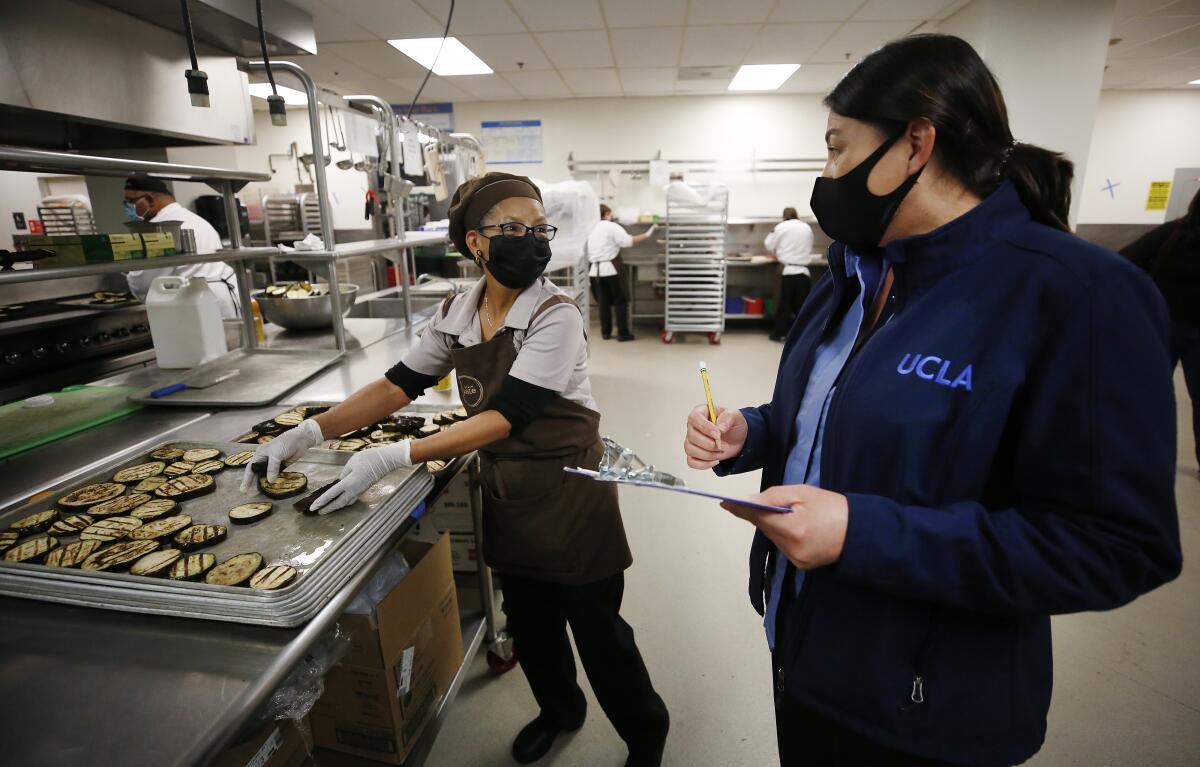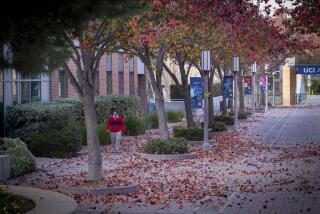Several UC chancellors call for tuition increase amid pandemic-fueled budget crisis

As the pandemic throws the University of California into one of the worst financial crises it has ever collectively faced, top leaders at the majority of campuses say it’s time to consider a tuition increase for fall 2022.
Chancellors and senior leaders at five of the nine UC undergraduate campuses told The Times that the staggering financial hit to their operations triggered by the coronavirus crisis and a $300.8-million proposed state budget cut this year have underscored the pressing need to open talks about tuition rates — which regents have increased just once for California students since 2011.
The financial squeeze has prompted campuses to slash budgets, dig into reserves, borrow funds, substantially halt hiring — and, at UC Riverside, propose axing its athletic program, drawing hundreds of protest letters, emails and calls.
Last March, UC regents had been expected to vote on a proposed five-year plan to raise tuition and fees that would have begun this past fall. Under the proposal, tuition and fees would have increased by inflation plus 2% for new UC students and guarantee them that same tuition level for six years. The plan would have raised more financial aid, effectively lowering the cost of attendance for more than 100,000 needy students, and give both families and campuses financial predictability.
But the proposal was shelved after the coronavirus crisis upended the economy. No tuition hike has been proposed for next fall, so the earliest one could take effect would be for fall 2022. California students currently pay $12,570 in annual tuition and fees; nonresidents pay an additional $28,992, but financial aid covers tuition for the majority of undergraduates.
“We’ve been eating at our fat for a long time and what I’m saying now is that we’re down to the bone,” UC San Diego Chancellor Pradeep Khosla said. “Even though this is not a perfect time for a tuition increase, it is a good time to start thinking about it.”
The UC Student Assn. opposes any tuition increase — especially now, when many students and their families are struggling with job losses and housing and food insecurity, President Aidan Arasasingham said.
Rather than higher fees, he said, students need more financial aid, mental health services, broadband access and academic preparation programs.
“Because students and families are hurting so much now, we can’t put the burden of closing budget deficits on their backs,” Arasasingham said.
What’s more is that in lawsuits across California and the nation, some students are demanding tuition refunds, saying they are being shortchanged by the wholesale move to online learning.
UC Board of Regents Chair John A. Pérez did not comment on whether he believed it was time to talk about tuition but said the issue has not been scheduled for a board discussion at this time.
Systemwide, UC took a $2.7-billion financial hit between March and October — about 6.5% of its $41.6-billion operating budget, mainly from lost income from medical centers, housing and dining and added costs for coronavirus testing, tracing, personal protective equipment, deep cleaning and the move to online instruction. As a result, campuses are scrambling to make ends meet.
UC President Michael V. Drake has largely empowered campuses to come up with their own budget plans but directed them to preserve jobs as much as possible and ensure that higher-paid employees make bigger salary adjustments than lower-paid workers “in the spirit of equity and fairness.”
At UC Riverside, the pandemic has magnified funding inequities, Chancellor Kim Wilcox said.
Riverside receives the lowest level of state support per California resident among UC undergraduate campuses — even though it educates the largest proportion of low-income and underrepresented minority students along with UC Merced.
Wilcox said the $175-million financial hit to Riverside’s$1-billion budget is “by far the worst” of his career, exacerbating what he described as the campus’ historically fragile operation.
Unlike UCLA, Berkeley or San Diego, UC Riverside does not attract many higher-paying students from other states and countries. Nor does Riverside have a large endowment — about $250 million compared with UCLA’s $5.4 billion.
To close the budget gap, Riverside has imposed some layoffs and is asking campus officials to reduce spending by up to 15% — among the system’s most severe measures. Axing athletics and study programs abroad, in Washington, D.C., and in Sacramento would diminish the college experience for UC’s neediest students, he said.
“It’s just really frustrating to me that you can be a student in the University of California...and depending on which city you happen to be residing in you have access to athletics and all kinds of other things that you wouldn’t somewhere else,” Wilcox said.
He said UC needs a plan for “reasonable and consistent” tuition increases. “The sooner we can get to it, the better,” he said.
At UC Berkeley, Chancellor Carol Christ also urged that the earlier conversation on small and limited tuition increases resume to help the campus address what she called the most severe financial crisis of her career — the first time nearly all revenue sources have been affected at once.
Berkeley had just dug itself out of a $150-million budget hole when the pandemic created a new shortfall of $340 million — driven by a state budget cut of $42 million, fewer tuition dollars due to a last-minute enrollment loss of about 800 students, higher costs for coronavirus testing, cleaning and online education, plunging housing and dining revenues with about 2,000 students filling just 20% of campus beds and huge losses from canceled sports events and arts performances.
That budget gap is now down to about $200 million after Berkeley imposed a hiring freeze, cancelled merit raises and ordered a budget cut of 3% across many campus units. Christ said more actions will be needed — she announced plans this week to begin reducing work hours in February — and ultimately Board of Regents approval of a new tuition plan.
“Regular, small tuition increases really need to be part of the solution,” she said.
UC Santa Cruz was hammered with not only the coronavirus crisis, but also wildfires that forced a campus evacuation in late August — delaying plans to ramp up coronavirus testing and requiring extra measures to make sure buildings were safe for the new fall term. Santa Cruz ended up housing only 950 of 2,300 expected students, lost some nonresident tuition revenue and took a 10% state budget cut.
Chancellor Cynthia Larive said she favors the tuition plan proposed earlier this year because it would help cover rising campus costs while raising more financial aid for needy students.
“People don’t like the idea that tuition is going up but we can do it in a fair, equitable and predictable way,” she said.
At UCLA, Chancellor Gene Block was circumspect, saying tuition was an issue for regents to decide. Among UC campuses, UCLA has faced the biggest financial squeeze of $725 million.
Some of the losses involved its medical operations, which have since rebounded; enrollment, philanthropy and research have all remained strong, said Gregg Goldman, chief financial officer. But UCLA took a $60-million cut in state funding and lost significant revenue by housing only 700 of 16,000 students who normally live on campus; daily meals are down to 1,000 from the usual 32,000.
Block said the financial shock initially made him feel ill and a bit frightened, as he wondered whether UCLA could continue to deliver a quality education remotely and protect its employees from layoffs. But the campus was able to make ends meet through a hiring slowdown, voluntary separations, an internal loan and a longer winter break.
UCLA also launched a program to retrain and reassign idled workers — redeploying food service workers to make meals for low-income families in partnership with the Venice Family Clinic, for instance.
Those actions helped Block recently commit to no pandemic-related layoffs through next June.
“This is not inexpensive, but we just feel this is the right thing to do,” he said. “I think we’ll all get through it.”
UC Irvine’s interim provost, Hal Stern, said he agreed “a hundred percent” that it was time to talk about tuition rates, even though the campus was able to fill a $67-million budget shortfall and achieve its UC-imposed $12-million savings target with no pandemic-driven furloughs or layoffs this year.
Stern said the campus instead dug into reserves, made a 2% budget cut and dramatically slowed down hiring, including largely pausing midway through a plan to add 250 new faculty.
UC San Diego officials also moved swiftly to address the financial havoc created by the coronavirus crisis, which resulted in funding losses of more than $300 million. Khosla and his team eliminated 370 positions through attrition, asked most units to make a 4% budget cut, took out a loan and froze $1.7 billion in capital projects.
But the campus saw tuition revenues rise above expectations with record fall enrollment —a gain of 840 students instead of an expected loss of 800. Khosla attributed the influx in large part to its management of the pandemic, which allowed San Diego to house 9,300 students, filling 55% of bed capacity — the highest proportion in the UC system.
Khosla also was able to rule out pandemic-related campus layoffs through next June. But he reiterated that the tuition conversation should begin now to preserve the quality of the renowned university system for all Californians.
“By investing in UC, you’re literally investing in the state and job creation, technology creation, economic development,” he said.
More to Read
Sign up for Essential California
The most important California stories and recommendations in your inbox every morning.
You may occasionally receive promotional content from the Los Angeles Times.










